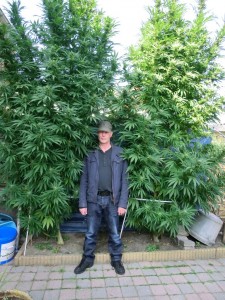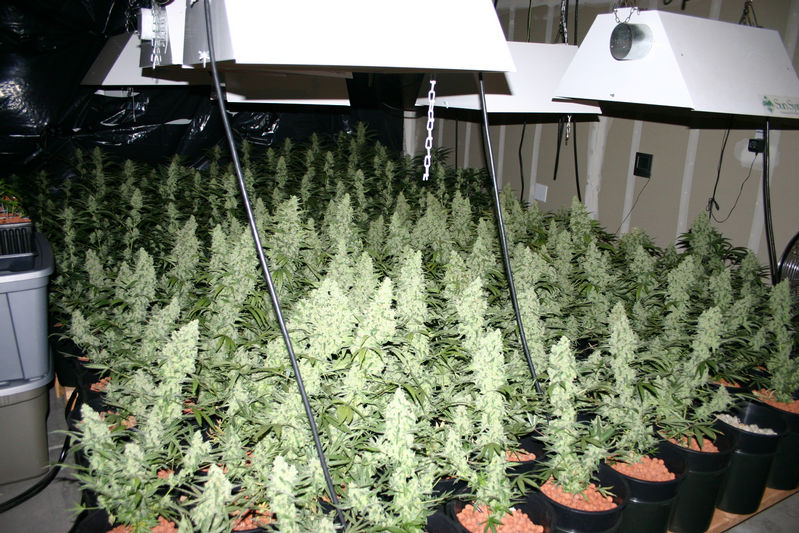
Marijuana naturally grows into a conical shape, with a large central bud and progressively longer branches toward the base of the plant. There are several potential benefits to altering your marijuana plant shape.
Altering the shape of your marijuana plants can increase harvest weight per plant, which is very useful to medical growers because most state’s MMJ laws restrict gardens by the number of plants allowed. Choosing the right plant shapes for your garden can also ensure that you are making the most of your space and light, which is important to all indoor growers concerned with their electric bills.

Sea of Green
Short, straight plants with large central buds. ‘Sea of Green’.
The most efficient method of producing excellent cannabis is by a method known as ‘Sea of Green’. In a sea of green configuration, small plants are packed tightly together (from 8″-12″ apart) and induced to flower after only a week (8″ apart) or two (12″ apart) of vegetative growth. Each plant grows 2′-3′ tall, with a large central bud and very few branches. With a sea of green configuration, up to 20 plants can be harvested every 9 weeks (more or less depending on the strain) with a single 400 watt HPS light in a 32″ x 40″ x 4′ (tall) growing space.
Unfortunately, since medical marijuana laws restrict gardens based on the number of plants, the sea of green configuration is almost never used in legal US gardens.
Lollipopping
Mid-size and larger plants with the lowest branches removed. ‘Lollipopping’.
In indoor gardens, the lowest leaves and branches of a plant only receive a tiny fraction of the light received from higher areas of the plant. Since light intensity fades at the square of the distance traveled, a leaf 36″ from a light source will receive only one quarter the energy received by a leaf 18″ away. Removing the leaves and branches that will be receiving very little light will increase the yield of the plant, because the plant won’t waste any energy building new leaves and buds where light is scarce. Since we are already more than 90 million miles from the sun, outdoor plants receive the same amount of light on all leaves that are not shaded.
Another benefit of removing the lowest leaves and branches of a plant is that the plant receives better air circulation around the central stem, reducing problems of mold or insects.

Topping
Central stem pruned (trimmed) at the top, producing multiple main buds. ‘Topping’.
A plant that has been ‘topped’ will grow two or more main buds instead of just one. Topped plants often look like rounded bushes, and can be of any size. The effectiveness of topping depends largely on the source and configuration of light, as well as the particular strain grown. Indoors, topping works well to get the most efficient use of your light. Rather than having a 5′ tall plant with a single main bud, a 3′ tall plant with several (6-9) main buds can be grown. This is useful for the same reason as ‘lollipopping’ the plants; the lower sections of the plant receive only a fraction of the higher sections. By keeping several buds at the same distance from the bulb, yields can increase dramatically.
A special form of topping, known as FIM, leaves part of the central growth intact. This stunts, rather than removes, the central stem so that several others will reach similar size and height. The effectiveness of FIM over topping is widely debated. If you’ve used FIM technique before, please let us know how it worked for you.
There is also a special plant configuration which combines all three of these shaping techniques, called Screen of Green, which I will be covering in an upcoming article. Plants can be bent or trained into special configurations for special purposes as well, which will also be covered in an upcoming article.









